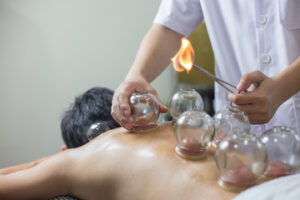Acupuncture and Wellness – What You Should Know About Cupping
Acupuncture & Wellness offers a cupping process that is similar to that of acupuncture. However, instead of putting needles in the skin, cups are placed over these points. The suction from the cups draws the skin upward into the cup, breaking blood capillaries and causing a bruise. This marks the area where blood flow was impeded, and the round bruises signify that the area has begun to heal naturally. While cupping is considered a safe treatment for many conditions, it’s a good idea to talk to your doctor before starting this therapy.

Cupping is an ancient therapy used for thousands of years. Many people swear by its therapeutic benefits, from pain to digestive disorders to skin conditions and respiratory problems. While it isn’t safe for everyone, it can help ease chronic and temporary ailments symptoms. A qualified practitioner should always perform the treatment, as most medical professionals don’t have extensive training in complementary medicine. However, many believe that cupping can be a safe and effective complementary care option.
The pain associated with cupping is usually mild and will fade after a few days. The only side effect is the potential for discoloration, which is common and temporary but can be permanent. The marks that form are a diagnostic indicator of the effectiveness of the treatment. The treatment is safe for most patients, and the marks themselves will typically disappear within a week. It’s important to know that some discoloration accompanies a successful cupping session.
After cupping, you should drink plenty of water and avoid fatty and rich foods. In addition, you should increase your fluid intake by about 20% during the first few days. After the procedure, your skin may feel slightly warm, and you may sweat or perspire a little bit. During this time, your muscles will relax, which helps improve circulation. It would help if you also tried not to exercise after cupping as it can lead to nausea and lightheadedness.
After cupping, the skin may feel slightly bruised. This is normal and is a good sign. A round bruise signifies that the blood is concentrating in the affected area. A blister is a sign that the blood has been drawn to the surface of the skin. This type of inflammation will last for about a week. You may also experience some sweat, a warm feeling, or even relaxation during the first day after cupping.
After cupping, you may feel some pain and a red mark. This is normal and is a sign that the treatment is working. The marks will fade within a few days, but they are diagnostic for physicians. Some patients seek out cupping treatments regularly as a way to prevent pain and improve circulation. A professional will be able to perform the procedure safely and effectively. The most important factor is timing. If you can’t keep the appointment for a couple of weeks, it’s probably a good idea to book a few sessions with a qualified medical practitioner.
After a cupping session, you’ll have some discoloration in the area. This is normal and a sign that the treatment has been successful. It will also make you feel more relaxed. As a result, your body will have less pain, and you’ll be more alert. Cupping is safe for most people, so you should consult with a medical professional if you’re unsure of your condition. In fact, many patients find it beneficial, and don’t hesitate to try it if it’s right for you.
When you have a cupping treatment, the cup will be heated to cause the skin to bleed. Your physician will check the resulting red marks to ensure that your treatment is effective. Your doctor will be able to determine what the marks mean and whether they’re due to a medical condition. It’s important to consult a trained professional before you try cupping. The results from the treatment are permanent and can last for years to come.
Most patients find that the experience is painless and that the results are long-lasting. They will see a discoloration after the procedure, but the discoloration will disappear within a week. In some cases, the discoloration will be local and temporary and will not bother you. It’s important to consult with a health care professional to ensure you’re getting the best results from cupping. While the treatment can leave a small mark, it is not necessarily a permanent scar.

